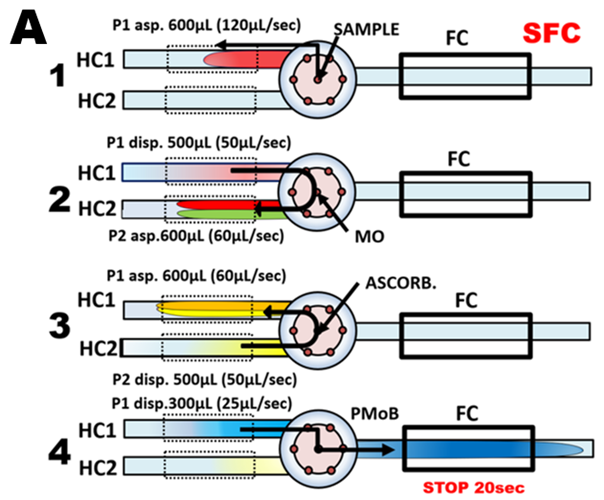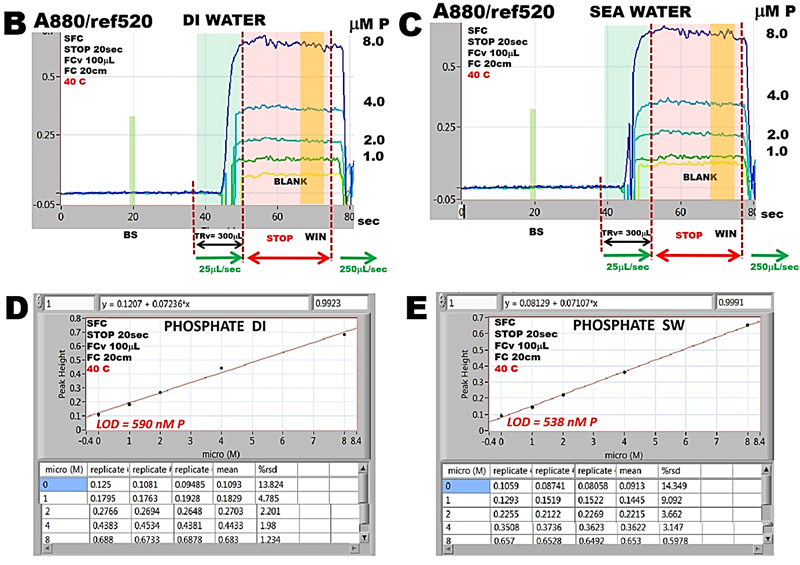3.2.4.2. Calibration obtained with DI water standards applied to analysis of sea water samples
Determination of nutrients in sea water by flow based techniques presents a challenge because salinity affects reagent based assays with spectrophotometric detection in two ways:
- By Schlieren effect
- By influence on reaction rates
Therefore, calibration of flow analyzers must be performed with standards having the same salinity as samples to be analyzed. (Worsfold 2013)
However, in ocean salinity can vary from 0% in coastal waters up to 3.5% in open ocean which makes sample/standard matrix matching of samples collected from coastal areas with variable salinity impractical. Matrix matching for analysis of samples collected in open ocean, where salinity is constant, faces yet another challenge; sea water to be used for matrix matched standards has to be thoroughly purified from traces of nutrients to be determined to reduce blank values and limit of detection (LOD). The thus prepared Low Nutrient Sea Water (LNSW), must be filtered to remove microorganisms and stored in darkness to prevent the (further) growth of organisms. Therefore, LNSW collected at different locations and prepared by different methods may differ in composition. Therefore, alternatively, use of artificial sea waters was proposed (four preparations of different composition, as well as commercial one-Sigma) (Yebra-Biurin 2009).
An another approach – elimination of Schlieren effects by optical means or by calculation met with limited success (Zagatto 1990, McKelvie 1997)
Therefore, so far a satisfactory resolution of salinity interference has not been found, although the interference impacts both Flow Injection (Worsfold 2013) as well as air segmented continuous flow systems (CFA), (Amoyama 2012, Coverly 2012)
These issues will be eliminated, and instrument calibration will be based on uniform foundation, if deionized water, which is readily available in pure, uniform composition, will be used for preparation of calibration standards, and pFI-LOV instrument is programmed in such a way that calibration line obtained with DI based standards will be the same as calibration obtained with SW based standards.
For the determination of phosphate pF-LOV instrument was programmed to function in batch mode in steps 4 and 5 of the flow protocol (A). The instrument was calibrated by automated Single Standard Solution method, (Section 3.2.5.), with standard solutions being prepared either in DI or sea water. The absorbance/time calibration runs obtained with standards prepared in DI water (B) and sea water (C) are identical.
 The corresponding, calibrations (D,E) are linear and ratio of slopes of DI/SW calibration lines is 1.02. Therefore calibration lines can be deemed identical because the difference is within r.s.d of (D, E) calibration runs.
The corresponding, calibrations (D,E) are linear and ratio of slopes of DI/SW calibration lines is 1.02. Therefore calibration lines can be deemed identical because the difference is within r.s.d of (D, E) calibration runs.
 The experiment presented here validates concept of singe line calibration. However, the SCL method is thoroughly documented in a recent publication (Hatta 2021) on determination of trace nutrients in sea water. Flow protocols for nitrite (F), phosphate (G) nitrate (H) and silicate (I) in batch mode were optimized, and calibrations by standards prepared by manual serial dilution in DI and SW water were performed.
The experiment presented here validates concept of singe line calibration. However, the SCL method is thoroughly documented in a recent publication (Hatta 2021) on determination of trace nutrients in sea water. Flow protocols for nitrite (F), phosphate (G) nitrate (H) and silicate (I) in batch mode were optimized, and calibrations by standards prepared by manual serial dilution in DI and SW water were performed.
.png.aspx?width=631&height=500)
 Calibration line ratios CR for nitrite, phosphate and silicate, (J), are within r.s.d. of the reproducibility of the pFI-LOV method, and therefore DI calibration can be applied for SW samples. Results for nitrate should be corrected by CR or method should be further optimized by improving nitrate to nitrite conversion on Cd column. The second components of linear regressions, values of DI and SW offsets are very close to each other (OD column 5) and therefore DI offset- and calibration line- will yield correct result for SW determinations. Also because OD values are about 1/10 of LS values.
Calibration line ratios CR for nitrite, phosphate and silicate, (J), are within r.s.d. of the reproducibility of the pFI-LOV method, and therefore DI calibration can be applied for SW samples. Results for nitrate should be corrected by CR or method should be further optimized by improving nitrate to nitrite conversion on Cd column. The second components of linear regressions, values of DI and SW offsets are very close to each other (OD column 5) and therefore DI offset- and calibration line- will yield correct result for SW determinations. Also because OD values are about 1/10 of LS values.
Note that CR values for phosphate obtained by flow schemes (A and G) are identical, although calibration methods (automated vs. manual), sequence of reagents, mixing ratios and slopes of calibration lines are different. This is because both protocols are programmed in batch mode.
While the concept of the Single Calibration Line is now verified by these results the method is being further developed by analyzing reference materials and by being used on board for analysis of samples collected during cruise in Northern Pacific.
P. J. Worsfold, R. Clough, M.L. Lohan, P. Monbet, P.S. Ellis, C.R. Quetel, et al., “Flow injection analysis as a tool for enhancing oceanographic nutrient measurements- A review”, Anal. Chim. Acta 803 (2013) 15–40.
M.C. Yebra-Biurrin “Flow Injection Analysis of Marine Samples” Nova Sci. Publishers N.Y.2009. p.41.
E.A.G. Zagatto, M.A.Z. Arruda, A.O. Jacintho, I.L. Mattos, “Compensation of the Schlieren effect in flow-injection analysis by using dual-wavelength spectrophotometry” Anal. Chim. Acta. 234 (1990) 153-160.
I.D. McKelvie, D. M.W. Peat, G. P. Matthews, P. J. Worsfold “Elimination of the Schlieren effect in the determination of reactive phosphorus in estuarine waters by flow-injection analysis” Anal. Chim. Acta 35 1 (1997) 265-27 1.
M. Amoyama et.al. “Report from an International Nutrient Workshop focusing on Phosphate Analysis” Royal Netherlands Institute for Sea Research Texel, Netherland, 12-15 November 2012, ISBN 978-4-908583-01-8
S. Coverly, R. Kerouel, A. Aminot, ” A re-examination of matrix effect in the segmented flow analysis in sea and estuarine water” Anal. Chim. Acta. 712 (2012) 94-100.
Mariko Hatta, Jaromir (Jarda) Ruzicka, Christopher I. Measures, Madeline Davis “Programmable flow injection in batch mode: Determination of nutrients in sea water by using a single, salinity independent calibration line, obtained with standards prepared in distilled water “Talanta 232 (2021) 122354